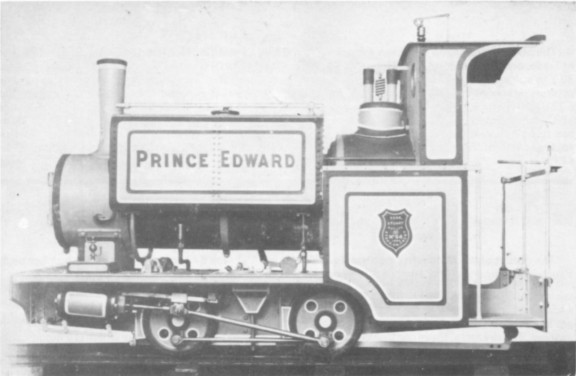
| THE INDUSTRIAL RAILWAY RECORD |
© JUNE 1971 |
KERR STUARTS FOR SOUTH AFRICA
K. P. PLANT
Kerr Stuart locomotives went to most parts of the World, and it is not surprising that at least twenty-four found their way to South Africa. The first, a small 2ft 0in gauge 0−4−0 saddle tank with a marine type firebox, was ordered on 13th January 1894 by the Damaraland Guano Company of South Lambert Road, London, and shipped to South West Africa later the same year: it was painted yellow and named PRINCE EDWARD. According to Moir & Crittenden in "Namib Narrow Gauge" (Oakwood Press), the railway was some thirteen miles in length and connected the guano deposits with a somewhat dangerous landing place at Cape Cross, about a hundred miles north of Walvis Bay. When operations ceased in 1906 the railway was abandoned, but whether the equipment was taken away or left on site is not known.
Another small locomotive of the "Midge" class about which little is known was ordered on 1st October 1897 by the Natal Collieries & Durban Coaling Station Ltd of 170 Gresham House, Old Broad Street, London. Named SIR JOHN ROBINSON and painted black with red and yellow lining, it was despatched to Natal where presumably it worked on the docks. Nothing more seems to be known of its history. According to "The Railway Engineer" of March 1890, Sir John Robinson was then ‘the editor of one of the leading Natal newspapers and a member of the Natal Legislative Council’.

Hunslet’s album of official Kerr Stuart photographs contains these two of PRINCE EDWARD (84 of 1894) which is thought to have been built originally as an 0−4−2ST (upper) but shipped as an 0−4−0ST (lower), Notice the different styles of lettering and lining out, and the most unusual shape of the worksplate.
(Courtesy Hunslet Engine Co Ltd)

The first narrow gauge railway in the Cape Colony was in territory bounded entirely on the landward side by German South-West Africa. Initially projected merely to connect the jetty with the town, the Walvis Bay Railway was opened in 1899 and ran for twelve miles up to the German border at Plum. On 6th March 1899 the Agent General for the Cape of Good Hope ordered a "Sirdar" class locomotive named HOPE which was almost as long in transit to Walvis Bay – where it arrived on 22nd August 1899 – as it had been in the building. Because of the extremely light nature of the track (12lb rail with sleepers spaced three feet apart) HOPE was provided with an additional pair of carrying wheels at both ends. Even so the maximum axle load of HOPE in working order would be about 1¾ tons, which is considerably more than today’s suggested figure for this category of track of 1 ton 4 cwt. Within six years the railway was virtually moribund and by 1915 HOPE had been laid aside and forgotten. It was later resuscitated and after many years on exhibition at Windhoek was returned to Walvis Bay in 1963 for preservation at the new railway station.
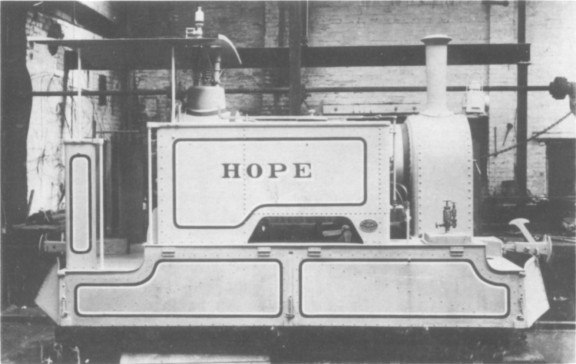
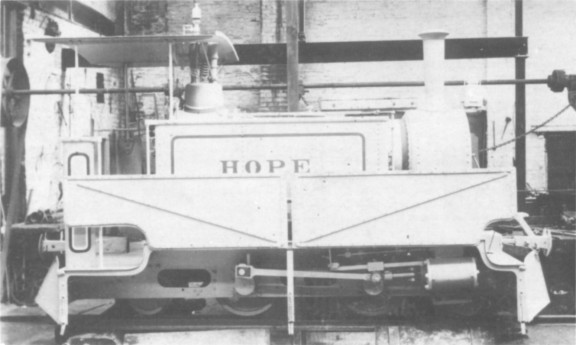
Two views of HOPE (Kerr Stuart 652 of 1899), a typical "Sirdar" class locomotive but with two additional axles to spread the weight. (Courtesy Hunslet Engine Co Ltd)
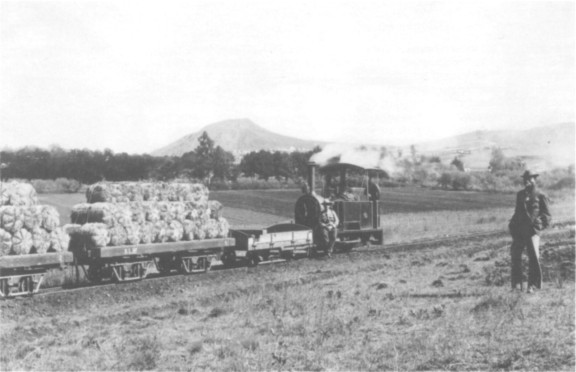
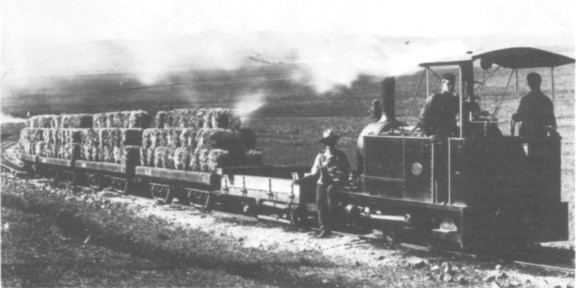
Kerr Stuart 677 pauses on the Bezuidenhout Light Railway whilst the photographer scurries to take these two pictures. (Courtesy Hunslet Engine Co Ltd)
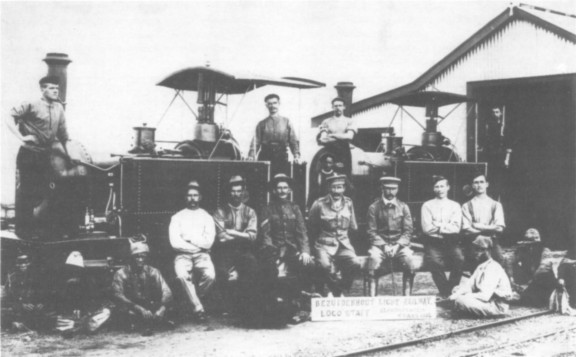
Blacks and whites pose together in pre-apartheid days on the Bezuidenhout Light Railway. The thoughtful positioning of heads enables us to read the worksplates and to say that Kerr Stuart 677 is on the left and 676 on the right. (Courtesy Hunslet Engine Co Ltd)
We are able to reproduce some rather fine photographs of Kerr Stuart 676 and 677 which were ordered on 17th November 1899 by the War Office (Director of Army Contracts) for delivery in seven days! It was possible to meet this contract date as three identical "Sirdar" class locomotives for Sir John Aird’s Nile Barrage contract in Egypt were under construction when the order was received and two were diverted to the War Office. After a sea journey to Cape Town and overland transport to Elandsfontein in the Transvaal, they were placed in service on the Bezuidenhout Light Railway. At this time the Second Boer War was in progress with the railways in the Orange River Colony and the Transvaal under the control of the Imperial Military Railways. According to "The Railway Engineer" for November 1900 (quoting from the "Pall Mall Gazette"), ‘within a week or two of the occupation of Johannesburg, the Military Governor cut the first sod of a new railway between Vereeniging and Elandsfontein. No doubt strategic reasons dictated the necessity of this line, but there were diplomatic motives at work as well. The present line of the Netherlands Co. between Vereeniging and Johannesburg is 49 miles in length, bearing considerably to the eastward from Viljoen’s Drift, so as to strike the junction of Elandsfontein, 10 miles east of Johannesburg. It has gradients as high as 1 in 33, a source in itself of considerable inconvenience and delay, as all trains from the south have to be broken up at Vereeniging and despatched over the Netherlands R. in sections. The Imperial Military R., now in course of construction, will bear to the north-west after leaving Viljoen’s Drift, on the south, striking the Witwatersrand near the Croesus Mines, a few miles west of Johannesburg, whence it follows the Main Reef road straight to Elandsfontein. Half-way between the Rand and Viljoen’s Drift it touches the farm Syferfontein, thereby opening out the Syferfontein coalfields. . . .‘ The present writer would be pleased to know whether the Bezuidenhout Light Railway was located near the ‘junction of Elandsfontein’ (presumably the present-day Germiston) for there is an Elandsfontein WNW of Pretoria and another SSW of Johannesburg. After the War both locomotives were acquired by the Central South African Railways and employed on the Pankop Light Railway (Pienaarsrivier to Settlers) which was opened on 21st June1906. When the South African Railways (SAR) administration was formed in 1910 they became Nos. NG40 and NG41 of Class NG1. I imagine they were scrapped many years ago.
On 19th September 1903 J. L. Hulett & Sons Ltd of West Street, Durban – one of the major sugar producers in South Africa – ordered one of the earliest of their many locomotives. Kerr Stuart 764, a "Waterloo" class 0−4−2 side tank, was painted in "standard" colours and shipped to Durban for the all−in price of £1,038; construction costs were estimated at £776. Its most likely destination was the Kearsney Estate. This was linked to the main line at Stanger eight miles away by the Stanger-Kearsney Light Railway which had been opened in 1901 (2nd January or 13th March? – authorities differ). It was cheaply constructed with 30lb rails and had a ruling gradient of 1 in 30. In addition to the normal traffic of sugar and tea, passenger trains were operated until about 1930. The railway was closed at an unknown date and although a lot of the track has been lifted some was incorporated into the Darnall Estate system.
Kerr Stuart 764 seems to be unknown to South African enthusiasts, and it would appear to have been scrapped many years ago. In 1911 and 1915 spare parts were sent out and ‘K.Y.’ in the shipping mark for the former consignment (‘J.L.H., K.Y., DURBAN’) could indicate that the destination was Kearsney.
Orders for nine 2ft 0in gauge locomotives were placed by the High Commissioner for the Union of South Africa on 10th January 1911 (Kerr Stuart 1207 and 1208), 28th September 1912 (1294, 1295) and 10th June 1913 (1342-1344; 1345-1346). Kerr Stuart appear to have lost money on these contracts but this was not an uncommon experience at this time. The estimated construction costs and selling price for each locomotive for the three orders were: £1033. £1025 free on board; £2096, £1736 fob; £2113, £2097 fob and £2501, £2197. While the seven 4−6−2 side tanks had outside frames and Walschaerts valve gear, the two 4−6−0s (1345-1346) were derived from an earlier Baldwin design with traditional American bar frames. The 4−6−0’s were shipped to Algoa Bay (Port Elizabeth), but the 4−6−2 tanks went to Durban. Kerr Stuart records suggest that the first four (South African Railways Nos. 10,11, NG12 and NG13) were intended for the Stoortstown Railway in Natal which was opened from Umzinto to Donnybrook on 3rd June 1908. However, Sydney Moir in "Twenty-Four Inches Apart" (Oakwood Press, 1963) lists all seven 4−6−2 tanks on the Alfred County Railway (Port Shepstone to Harding) of which the first section was opened on 8th November 1911. Confirmation of the original allocation would be welcome.
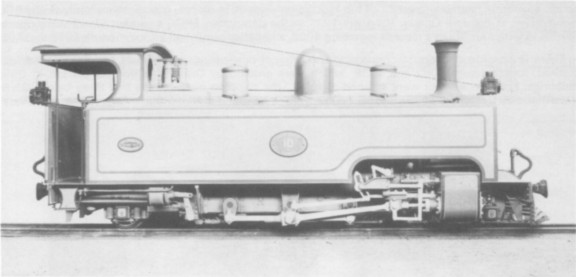
In 1906 Hunslet built a pair of 4−6−2 side tanks to Hendrie’s design for the Natal Government Railways (Hunslet 892 and 893). A further six appeared from Hawthorn Leslie in 1907, and the seven built for the SAR by Kerr Stuart in 1911-1914 were to Hawthorn Leslie drawings. Illustrated is SAR 10, Kerr Stuart 1207 of 1911. (Courtesy Hunslet Engine Co Add)
None of these 4−6−2’s remains in service on SAR today but Kerr Stuart 1208, sold in 1942 to the Savane Sawmills of Rhodesian Timber Concessions, may still survive at Savane, albeit now in the ownership of Zambesi Sawmills Ltd. In August 1970 Kerr Stuart 1344 was at Port Shepstone SAR shed allegedly awaiting preservation; it had been sold by SAR in 1957 to Rustenburg Platinum Mines Ltd in the Transvaal. The 4−6−0’s were allocated to the Port Elizabeth-Avontuur line and presumably succumbed around 1930 after the introduction of the Class NG/G13 Garratts.
One of the popular "Wren" class locomotives, with new style valve gear, was ordered on 19th September 1919 by Arkell & Douglas lnc. 40 Old Bond Street, London. Kerr Stuart made an estimated profit of £75 on the selling price of £895, and the locomotive was shipped two months later to Lake Mentz, via Algoa Bay. for the Sundays River Irrigation Board. I presume that this "Wren" was used on the constructlon of the Mentzdam which lies some sixty miles north of Port EIizabeth in the Witrugberge range of mountains. Whilst on the subject of "Wrens", it should be mentioned that Kerr Stuart 4006, originally supplied new together with 4013-4015 to the Air Ministry’s Northern Aircraft Repair Depot at Greenhill, Sheffield, later found its way out to the Eastern Province Cement Co Ltd at Port Elizabeth; Hunslet supplied a new boiler in 1935. There is no doubt that 4006 left England before 1930 as a Kerr Stuart clerk (Hunslet took over in 1930) entered in the Kerr Stuart Engine Book against 4006 ‘S.A.R. Delagoa Bay’. This same entry also appears opposite 4013 to 4015, but no orders for spare parts have ever been received by Hunslet and the whereabouts of these locomotives after they left Sheffield have never been traced. There is no record of them running on South African Railways (see RECORD 10, page 247) and, whilst one might speculate on them finding their way from Delagoa Bay (Lourenco Marques) to one of the many sugar estates in Natal or Moçambique, there is no evidence to suggest it. The driver of the superb Baldwin Pacific (61269 of 1930) at EPCC’s New Brighton cement works in Port Elizabeth, to whom I spoke in 1970, could remember only the one Kerr Stuart which he said was used on the construction of the 12-mile EPCC railway to Chelsea on the SAR’s Port Elizabeth-Avontuur line. He recalled the 1903 Bagnall 4−6−0 and the 1949 Hunslet 2−8−2 formerly used on the branch to Chelsea, but was not aware that EPCC had ever used locomotives at their quarries at Chelsea and Patentie. In "Industrial Locomotives of Southern Africa" (Union Publications, 1963) the EPCC stock is subdivided so that Kerr Stuart 4006 is listed at Patentie (incorrect) together with 4013-4015 which are asterisked as "Not certain". Moir, op cit. eminently readable throughout but tantalisingly vague in places, makes no mention of any EPCC locomotives at Patentie Quarry. He gives 1927 as the date when EPCC’s cement works were opened; this fits in with Kerr Stuart’s records regarding 4006, and belies published information on 4056 and 4063’
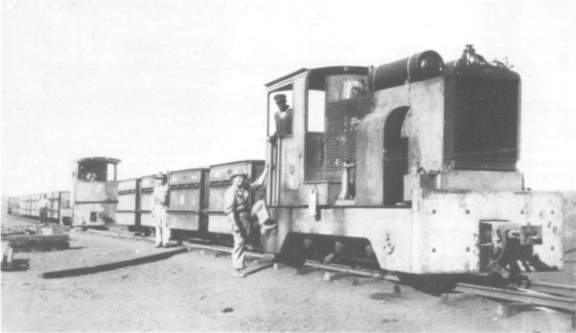
Kerr Stuart 6−wheel diesels I (right) and 2 (left) at the Associated Manganese Mines of South Africa Ltd. Postmasburg. The engine compartment ventilation grille was a feature on certain Kerr Stuart diesels. Notice the air reservoir for the air brakes. (Courtesy Hunslet Engine Co Ltd)
There is considerable doubt concerning the original destinations of the last two mentioned locomotives, together with 4062 and 4138, which were ordered by Durant, Radford & Co Ltd of Billiter Buildings, London. All four were shipped to Natal (the shipping mark for the first three being ‘GN&S, Natal’) and by December 1935 all except 4062 were to be found at lllovo Sugar Estates Ltd; 4062 was at Gledhow Sugar Estates Ltd. In "Industrial Locomotives of Southern Africa" 4056 and 4063 are shown as new to EPCC’s Patentie Limestone Quarry, and 4138 as new to Illovo. I am sceptical of the first destination, and the second is almost certainly wrong for when Neville Fields visited lIlovo in 1943 he was told that 4138 had been purchased second-hand from an unspecified wattle plantation. The date ordered, construction cost and selling price of these locomotives were – "Darwin" class: 4056 (9th January 1920, £1401, £1819), 4062 (1st August 1923, £961, £987) and 4063 (17th November 1923, £961. £981); and "Huxley" class: 4138 (18th August 1920, £2701,£3673).
Kerr Stuart 4420, ordered by Robert Hudson Ltd, 38A Bond Street, Leeds, on 20th February 1929, is thought to have been delivered new to Gledhow Sugar Estates Ltd. A geared ‘steam tractor’ with an enclosed vertical two-cylinder engine, it was scrapped about 1950. Among the last few locomotives to leave the California Works at Stoke before the final crash were four 90hp diesels ordered by Robert Hudson Ltd on 8th April 1930. The Kerr Stuart Order Book shows them as ‘for Johannesburg’ but they were consigned via Algoa Bay to an unknown destination, Spares were ordered from Hunslet in September 1936 for 4473, 4474 and 4476 by the Associated Manganese Mines of South Africa Ltd (incorporated in 1935, so they could not have been the original owners): and for 4475 in February 1937 by the same company although on this occasion the address ‘Glosam, Postmasburg’ was quoted. According to the 1960 edition of "Mining Year Book" the South African Government extended the Kimberley-Koopmansfontein branch line by 90 miles through Postmasburg to the centre of the manganese deposits at Lohatiha. Within the last few years this railway has reached Hotazel, a place so named because the temperature in summer is said to be as hot as hell!
I should like to acknowledge the assistance of Geoffrey Horsman during the preparation of this article.
|
|
ex−works |
gauge |
type |
cylinders |
coupled |
weight |
ordered by |
| 84 | 1. 9.1894 | 2ft 0in | 0−4−0ST | 5in x 10in | 1ft 7in | 4t 6c | Damaraland Guano |
| 110 | 12. 2.1898 | 3ft 6in | 0−4−2T | 7in x 12in | 1ft 4½in | 7t 16c | Natal Collieries |
| 652 | 1. 6.1899 | 2ft 6in | 2−4−2T | 6in x 10in | 2ft 0in | 5t 11c | Agent General |
| 676 | 23.11.1899 | 60cm | 0−4−0T | " | " | 5t 5c | War Office |
| 677 | " | " | " | " | " | " | " " |
| 764 | 20.10.1903 | 2ft 0in | 0−4−2T | 9½in x 15in | 2ft 3in | 11t 9c | J. L. Hulett |
| 1207 | 15. 9.1911 | " | 4−6−2T | 11½in x 15in | 2ft 6in | 22t 17c | High Commissioner |
| 1208 | 14. 9.1911 | " | " | " | " | 22t 18c | " " |
| 1294 | 29. 4.1913 | " | " | " | " | " | " " |
| 1295 | 5. 5.1913 | " | " | " | " | 22t 19c | " " |
| 1342 | 17. 7.1914 | " | " | " | " | 22t 17c | " " |
| 1343 | " | " | " | " | " | " | " " |
| 1344 | " | " | " | " | " | " | " " |
| 1345 | 24. 9.1914 | " | 4−6−0 | 11¾in x 16in | 2ft 9in | 28t 14c * | " " |
| 1346 | " | " | " | " | " | " | " " |
| 4006 | 31.12.1918 | " | 0−4−0ST | 6in x 9in | 1ft 5in | 3t 7c | Air Ministry |
| 4031 | 26.11.1919 | " | " | " | " | 3t 6c | Arkell & Douglas |
| 4066 | 29. 3.1920 | " | 0−4−2PT | 8in x 12in | 2ft 3in | 7t 16c | Durant, Radford |
| 4062 | 2.10.1923 | " | " | " | " | 8t 0c | " " |
| 4063 | 7. 1.1924 | " | " | " | " | 8t 6c | " " |
| 4138 | 10.11.1920 | 3ft 6in | 0−4−2T | 12in x 16in | 2ft 9in | 15t 8c | " " |
| 4420 | 28.10.1929 | 2ft 0in | 0−6−0TG | 6in x 8in | 2ft 0in | 10t 17c | Robert Hudson |
| 4473 | 7. 6.1930 | 2ft 6in | 6wDM | * * | " | *** | " " |
| 4474 | 17. 6.1930 | " | " | * * | " | *** | " " |
| 4475 | 5. 7.1930 | " | " | * * | " | *** | " " |
| 4476 | " | " | " | * * | " | *** | " " |
NOTES * weight of loco 19t 19c, tender 8t 15c
* * 90hp McLaren diesel engine
* * * approximate loaded weight 15t